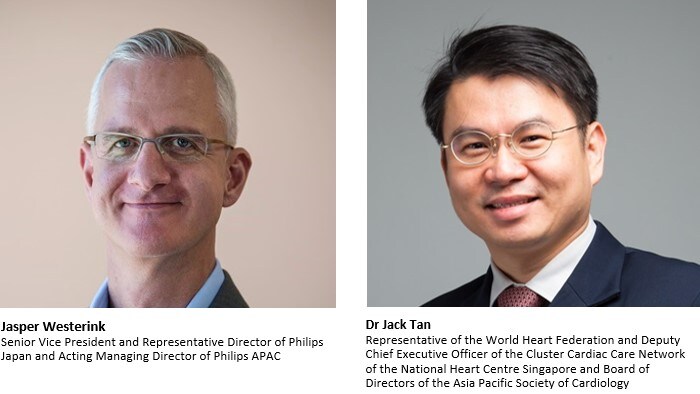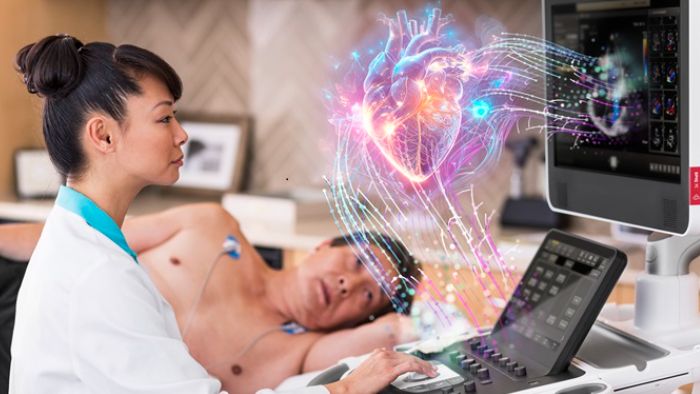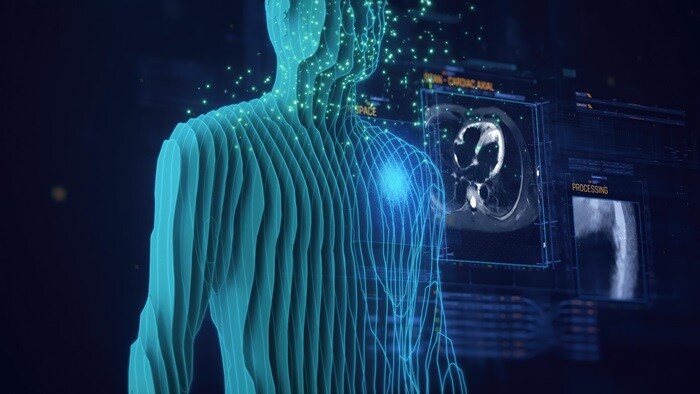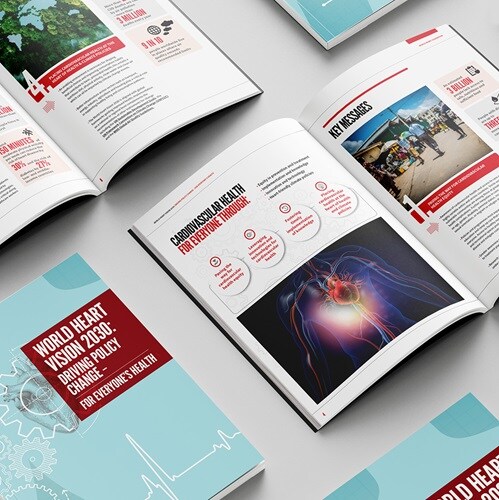Driving towards better cardiovascular care for more with innovation
Feb 25, 2025 - Reading time 4-6 minutes
A joint commitment to achieve better heart care for all in line with the World Health Vision 2030
Cardiovascular disease (CVD) is putting an unsustainable burden on individuals and healthcare systems. David, featured in this film by the BBC Storyworks, is one of the many patients who has been battling a life-threatening heart condition and had to undergo a heart surgery to prevent severe heart damage. In fact, the CVD burden will continue to rise, affecting nearly 730 million people in Asia by 2050 [1]. In Japan alone, the disease is already accounting for over 310,000 deaths yearly and a large proportion of the country’s medical expenses. [2]
Innovation and technologies are one of the key solutions to these rising statistics and a focus area of the World Heart Federation’s World Heart Vision 2030 initiative which aims to reimagine and redefine healthcare practice, policy, delivery, and access to reduce cardiovascular mortality and incidences. As we step into a new year, Dr Jack Tan, representative of the World Heart Federation (WHF) and Deputy Chief Executive Officer of the Cluster Cardiac Care Network of the National Heart Centre Singapore and Board of Directors of the Asia Pacific Society of Cardiology, together with Jasper Westerink, President Director of Philips Japan and Acting Managing Director of Philips APAC, discussed how health technology can be applied in addressing healthcare providers’ challenges to provide timely, quality cardiovascular care and improve heart care for all.

1. What are the key challenges faced by healthcare providers in managing cardiovascular care?
Dr Tan: Across Asia, the shortage of healthcare professionals, particularly doctors and allied health workers specializing in cardiovascular care, is creating a bottleneck in care delivery. In summary, there is an inconsistent quality of care across the region. The higher level of care provision is usually clustered in the capital cities while the rural areas have poor access to healthcare services, especially for acute cardiovascular care services. Additionally in underserved areas, inadequate access and adoption of clinical guidelines are affecting diagnosis, treatment and care planning. Delayed diagnosis remains a key challenge due to limited screening programs, low patient awareness and underdeveloped health systems. Furthermore, secondary prevention such as post- cardiac event rehabilitations and follow-ups are inconsistently delivered.
Although digital health solutions such as telemedicine, offer significant potential for improving CVD management, barriers such as digital infrastructure, healthcare providers' familiarity with technology, and patient engagement with digital tools hinder their widespread adoption. This challenge particularly impacts rural and remote regions where access to care is already limited.
Collaboration within and between sectors will be critical as the necessary changes to policy, systems and healthcare delivery will require the full knowledge, experience and resources of everyone with a shared vision of cardiovascular health for all.
Dr Jack Tan
Representative of the World Heart Federation (WHF) and Deputy Chief Executive Officer of the Cluster Cardiac Care Network of the National Heart Centre Singapore and Board of Directors of the Asia Pacific Society of Cardiology
2. How can innovation and technology enable better cardiovascular care?
Jasper: In cardiovascular care, timely diagnosis and intervention can mean a difference between life and death. Health systems are facing immense pressures to deliver on this growing care demand amid staff shortages and the challenges that Dr Tan mentioned.
Innovation in cardiac imaging technologies is key to ensuring more people have access to timely, lifesaving care despite an understaffed healthcare system. By harnessing the power of AI, healthcare professionals can deliver quality care and tackle complex patient needs in cardiovascular diseases. For example, integrating AI in ultrasound systems can help physicians detect, diagnose and monitor cardiac conditions with greater confidence and efficiency. AI algorithms integrated into MRI systems can significantly increase imaging speed and improve image quality. This addresses the need for faster and more accurate diagnosis for various complex and urgent cardiac diseases.
At RSNA 2024, we introduced the Cardiovascular Workspace which combines deep clinical expertise with technological innovations giving clinicians interoperable access to a variety of systems and applications to streamline data analysis and ensure efficient clinical decision-making to improve patient outcomes throughout the cardiovascular care continuum.

Generative AI with its ability to distill complex information into actionable insights will offer a range of opportunities to improve patient care. According to the FHI survey, healthcare leaders in Japan believe that data-driven insights could help to optimize treatment plans and care pathways (53%) and identify evidence-based best practices (43%) [3]. By combining predictive analytics capability with data from other sources such as the patient’s medical record, a more accurate and robust clinical prediction can be achieved, where clinicians can intervene and prevent poor clinical outcomes. In fact, AI-based prediction technology is already being used to reduce the number of cardiac arrests in the ICU.[4]
3. What some initiatives in APAC where technology is enabling better cardiovascular care?
Dr Tan: WHF believes in making the best use of innovation and technology to achieve better cardiovascular health and close the equity gaps. The use of digital health technologies such as telehealth, remote patient monitoring and AI could address many of these gaps, improving access to care and enabling early disease detection.
Across APAC, we can point to many initiatives that are helping to do so. One example is Singapore that is leading the integration of AI into healthcare. The National University Health System (NUHS) uses AI-powered tools for predictive analytics, which help in identifying high-risk cardiovascular patients and preventing future events. Wearable technologies, like smartwatches and fitness trackers, are also used widely for early detection of heart abnormalities. The newly set up SingHealth Duke-NUS Global Health Institute (SDGHI) in Singapore focuses on health and wellbeing in Asia and beyond. The cardiovascular component has already started awarding pilot research grants to study NCD health and rheumatic and congenital heart disease in Indonesia and hypertension management using digital health technologies in the slum areas of Bangladesh. SDGHI also focuses on regional education and policies in this space as well as hospital management courses related to these areas.
Another example is in Australia, where the SOLVE-CHD program incorporates telemedicine, mobile apps and wearable devices to monitor and manage cardiovascular health remotely. The program emphasizes secondary prevention, helping patients adhere to treatment plans and lifestyle changes after experiencing a cardiovascular event.
To move beyond the initial successes, we need to cultivate a better environment that enables the uptake of innovation and technologies, through efforts to make technologies more affordable and accessible in other areas, and by strengthening the capacity of the health system to integrate and deploy innovative models of care, develop national e-health policies and expand training for healthcare workers.

4. How can collaboration further uncover the power of innovation and technology in cardiovascular care?
Jasper: Partnerships across the healthcare ecosystem is key to creating a conducive environment for the adoption and application of innovation and technology to improve cardiovascular care. These include better integration and utilization of AI, data and digitalization in improve workflow, operational efficiency and cardiovascular health service delivery, There is also a huge opportunity to improve access of technologies to engage more people in their care journey and enable timely diagnosis and overall care to improve disease outcomes.
For example, to support healthcare professionals in the application of innovation and technology in cardiovascular care, Philips partnered with the RSJPD Harapan Kita Heart and Vascular Hospital in Indonesia to launch a Cardiovascular Education Excellence Program. As part of the three-year partnership, Philips offers various trainings on the latest innovations in cardiovascular care, along with equipment for RSJPD Harapan Kita staff to provide quality cardiovascular treatment services more effectively and efficiently.
Globally, cardiology leaders are increasingly looking to virtual care as a solution to navigate the impact of staff shortages on patient care at their organizations as the Future Health Index reports. At Philips, we have worked to Showa University in Japan in the application of telemedicine in ICU settings. Tele-ICU is defined as a system in which ICU professionals remotely support critically ill patients and on-site staff. With Tele-ICU, Showa University Hospital in Japan showed proven results in lowering overall mortality rates in ICU settings by more than half, from 8.5% to 3.8%. Access frequency of the on-site physicians was also reduced by 25%. These results suggest that the Tele-ICU could resolve the shortage of intensivists and reduce the regional disparities in intensive care resources.
5. How does WHF drive collaborations to realize World Heart Vision 2030?

Dr Tan: Collaboration within and between sectors will be critical as the necessary changes to policy, systems and healthcare delivery will require the full knowledge, experience and resources of everyone with a shared vision of cardiovascular health for all.
A key example is the ongoing World Heart Federation and Philips Foundation partnership to provide half a million children at risk of rheumatic heart disease (RHD) in the Philippines with access to life-saving early detection. The initiative targets a combination of challenges – low disease awareness, lack of healthcare access and treatment, inadequate diagnosis, and inadequate medical training – to drive a comprehensive approach in alleviating the burden of RHD. The partnership is led by the care providers and supported by the Ministry of Health, Ministry of Education, regional health authorities, national health professional societies and service providers across the country and will not be possible without the willingness and capacity of this wide range of partners to collaborate.
It is through locally driven and owned collaborations that draw on the different skills and resources of multiple stakeholders that the power of technology and innovation will best serve the needs of cardiovascular health of all.
In cardiovascular care, timely diagnosis and intervention can mean a difference between life and death. We need to co-create opportunities to transform the way care is experienced and delivered in a more effective, efficient, and sustainable way
Jasper Westerink
Representative Director of Philips Japan and Acting Managing Director of Philips APAC
According to World Heart Vision 2030, the ambition is simple: everyone to be empowered to access all aspects of cardiovascular health prevention and control. The strategies outlined by Dr Tan and Jasper will support healthcare systems across APAC, affected by workforce shortages, financial challenges, and a growing demand for care. The latest Future Health Index report reinforced these concerns, with nearly three in four healthcare leaders in APAC reporting delays in care due to staff shortages. In Japan, 80% of healthcare leaders see this shortage leading to increased burnout and mental health problems among their workforces [5].
Against this backdrop, advances in medical technology can significantly contribute to how medically advanced a country can be in cardiovascular care so that patients like David can have access to life-saving diagnosis. A holistic approach where multi-stakeholder partnerships facilitate education, training, innovations and access to care will be pivotal in the way forward.
References [1] The burden of cardiovascular disease in Asia from 2025 to 2050: a forecast analysis for East Asia, South Asia, South-East Asia, Central Asia, and high-income Asia Pacific regions
[2] Epidemiology of cardiovascular disease in Japan: An overview study
[3] Philips Future Health Index 2024: Japanese Report Better care for more people
[4] Subbe, C.P., Duller, B. & Bellomo, R. Crit Care (2017) 21: 52. doi:10.1186/s13054-017-1635-zSubbe, C.P., Duller, B. & Bellomo, R. Crit Care (2017) 21: 52. doi:10.1186/s13054-017-1635-z
[5] Philips Future Health Index 2024 Report: APAC Healthcare leaders taking bold and thoughtful changes to deliver better care for more people: APAC press release







